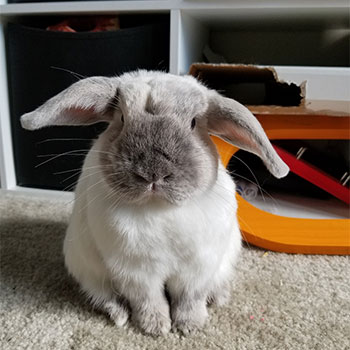Caring for Rabbits with Recurrent Bladder Sludge
On October 30, 2018, my three-year-old mini lop, JoJo, refused to come out of his cardboard house for breakfast. I knew something was wrong. Normally, he waited at the top of the stairs for me to deliver his greens. I tried calling his name and petting him gently, but he sat there, hunched and looking very much unlike himself. When I picked him up and turned him over, his legs were covered in urine, and there appeared to be blood coming out of his penis.
Upon farther inspection, I saw that the rug underneath his cardboard house was dotted with blood and lumps of off-white, sandy material. I immediately called his vet and rushed him in. The vet took an X-ray of JoJo’s abdomen and discovered a shocking amount of calcium in his bladder, which appeared bright white on the film. It was one of two things—a bladder full of sludge or a stone the size of a golf ball. Given the size of the calcium mass in JoJo’s bladder, his vet was worried he wouldn’t be able to pass it. So on Halloween day, JoJo went in for emergency surgery.
Thankfully, JoJo did not possess the largest bladder stone ever seen in a three-pound rabbit, but the vet did extract a handful of bladder sludge from my bunny.

What is Sludge?

Sludge is made of excess calcium. It’s normal for a rabbit to pass excess calcium from the body through the urinary tract, but in some rabbits, calcium salts build up and thicken in the bladder, forming bladder sludge. The sludge was pasty, almost like he was passing blobs of toothpaste every time he tried to use the litterbox, and the material was gritty like sand. It was a terrifying few days, but the surgery was successful. I thought it would be the last time I worried about sludge.
Unfortunately, I was wrong.
Almost six months later, JoJo started passing clumps of sludge again. The sludge cleared without surgery this time, but a few months later, the sludge returned a third time. It appeared that JoJo was one of those unlucky rabbits with recurrent bladder sludge.
Sludge can be very scary because it makes your rabbit sluggish, decreases their appetite, and causes a lot of pain. It also appears that some rabbits are genetically predisposed to the condition, so it can be difficult to know what causes the sludge to return. But there are ways to improve quality of life in rabbits with recurrent bouts of bladder sludge. Every time JoJo’s sludge returns, I catch it earlier and discover new ways to keep him healthier between flare-ups.
Living with a Sludgy Bunny
Know your rabbit’s behavior.
The first step in treating recurrent bladder sludge is knowing the signs and symptoms of a potential flare-up. For JoJo, his litterbox habits decline. He starts urinating around the room and “dribbling” urine as he hops. The quantity of urine decreases, and sometimes he only passes a very small amount. If you notice your rabbit’s litterbox habits are changing or urine output is decreasing, these could be signs of sludge building up inside the bladder.
Make sure your rabbit stays hydrated.
Adequate water intake helps keep the urine dilute and moves the bladder more frequently so bladder sludge has less time to settle and become a problem for your bunny. JoJo has two water bowls in his area, and I thoroughly wet his greens before I feed him so he gets extra water during mealtime.
Feed dried snacks.
I’ve noticed JoJo drinks more water when he eats dried herbs and veggies as treats rather than their non-dehydrated versions. Although he gets wet greens, for snacks I feed him dried plantain, nettle, coneflower, dandelion leaves, and Melissa (lemon balm). He is also a fan of dandelion roots and loves dried carrots and parsnip as much as their original forms. Switching your bunny to dried treats could encourage them to drink more water after snack time.
Keep your bunny moving.
Movement is also very important to keep bladder sludge from forming. If a rabbit is hopping around, the sludge has a harder time settling in the bladder and therefore is expelled more easily with dilute urine. Passing a few granules of calcium salt is a lot easier than trying to urinate toothpaste. JoJo was always a “free-range” rabbit, so space wasn’t his limiting factor. However, he’s a lazy bunny, and sitting around was causing him to build up more and more sludge. He needed motivation, and for JoJo the answer was food. I bought him a treat ball he has to chase around the room to get treats to fall out. Even laying out a trail of treats down the hallway from one room to the next gets him up and moving for his food rather than sitting still to eat. If you have a lazy bunny, try games and food rewards to trick them into exercise!
Watch for hidden sources of calcium.
Some commercial rabbit pellets contain alfalfa hay, which is very high in calcium and could contribute to additional calcium salts building up in the bladder. Rabbits older than a year should be fed timothy-hay based pellets. Also, many treats marketed for rabbits contain alfalfa, especially as a filler, so always check the ingredient label before feeding them to your bunny. I switched JoJo from tap water to filtered water because, depending on where you live, tap water can also contain added calcium. Filtered water gives me the peace of mind that JoJo is protected from added calcium in his water bowl.
Develop a good relationship with your vet.
Having a relationship with a rabbit-savvy veterinarian is extremely important when caring for a rabbit with recurrent bladder sludge. A vet gets to know your rabbit and their unique medical needs, and it is critical to have their condition monitored. Your vet may prescribe NSAIDs, which are very helpful in treating symptoms of bladder sludge once a flare-up is underway. It decreases inflammation, which makes it easier for the rabbit to pass the thick sludge, and it helps control pain so the rabbit will hopefully eat and keep moving, which speeds recovery. Antibiotics can also be necessary for a bad flare-up of sludge if it causes the bladder to become infected. A vet who knows you and your bunny will be an advocate for you on your rabbit’s journey with sludge.
Little Lifestyle Modifications
It’s possible to learn together with your rabbit so they can have a happy and fulfilling life with less-frequent flare-ups. A little lifestyle modification, some new treats and games, and a rabbit-savvy vet all make for a positive journey for a bunny with recurrent bladder sludge issues.
JoJo celebrated his fifth birthday this past Christmas Eve, and I cherish every day I get to share with him after fearing the worst in 2018. He got a bag of dandelion roots in his stocking, and he still does binkies when he sees me loading them in the treat ball.
Reviewed by HRS staff
Author: Alyssa Nedbal
Photo Credit: Alyssa Nedbal
Journal Issue: House Rabbit Journal, Summer 2020

Sign up to Our Newsletter!
Sign up for web update alerts and our monthly e-newsletter
to stay current on HRS, our Chapters, and info for your bunny.




